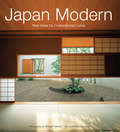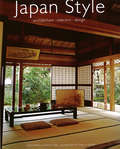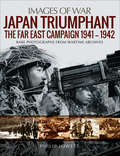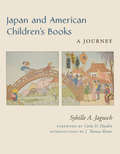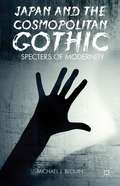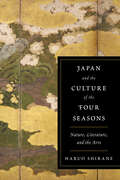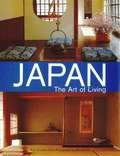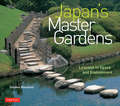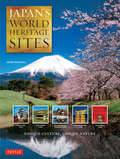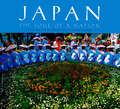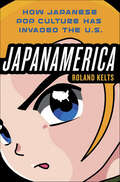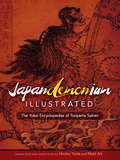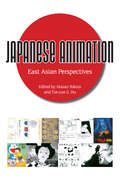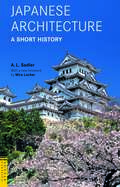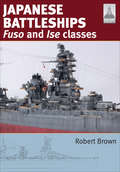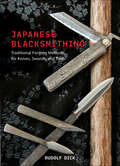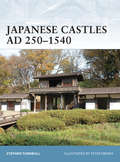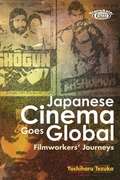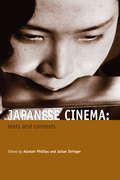- Table View
- List View
Japan Living: Form and Function at the Cutting Edge
by Geeta K. Mehta Marcia Iwatate Takeshi NakasaGain insight into both modern and Japanese styles with this stunning Japanese interior design book.Natural serenity, unostentatious refinement, clean lines and the balancing of light and space are all hallmarks of Japanese interior design. <P><P>In the new book from noted authors Marcia Iwatate and Geeta Mehta, Japan Living continues the themes of their highly successful Japan Houses with 30 specially designed houses that transcend function and resonate with spirit.The houses represented in Japan Living reflect the many changes in the dynamics of the new Japanese society, including an aging population and the desire to remain single; while others embody plenty of creativity, self-expression and individuality. Throughout, a return to traditional materials and design elements is married with such present-day requirements as minimalism, flexibility, a small kitchen, a beautiful bathroom, energy efficiency and electronic gadgetry. Each of these homes is an exquisite representation of the integrity consistently found within Japanese interior design, both in new construction and old.
Japan Modern: New Ideas for Contemporary Living
by Michael Freeman Michiko Rico NoseFeaturing over 200 stunning photographs, this Japanese design book captures the delightful, modern style of the Japanese home.Japan has always intrigued the world with its deceptively simple blending of architecture, landscape and design. <P><P>Zen temples, the famous tea ceremony, formal gardens, the use of wood, paper and other materials in the form of screens and floors--all have evolved over the years to create a varied, yet indisputably unique style. Japan Style showcases 40 contemporary homes, many never photographed before, and explores the unique Japanese design in all its manifestations. The book is divided into four chapters-- Reworking Tradition Managing Space Experimenting with Materials Personal Statements Each home is representative in its own way of the changing face of Japanese interior design and architecture and will be sure to inspire some new design ideas for your own home.
Japan Style
by Geeta K. Mehta Noboru Murata Kimie TadaEnter the world of the stylish Japanese house, where every object in sight is a work of art. Japan Style introduces 20 special residences. With more than 200 color photographs, this book showcases the stunning beauty of old homes, and reveals how they are cared for by their owners.Traditional Japanese homes, with superbly crafted fine wood, great workmanship and seasonal interior arrangements, have an aesthetic of infinite simplicity. Unlike Japanese inns and historical buildings, the houses featured in this book are private property and are not open to public viewing. Japan Style offers a rare glimpse into the intimate world of the everyday Japanese and fascinating insight into the traditional architecture of Japan.
Japan Triumphant: The Far East Campaign 1941-1942 (Images of War)
by Philip JowettImperial Japan&’s ambitious offensive at the beginning of WWII is captured in dramatic detail in this pictorial history featuring rare wartime photographs. The Japanese offensive in the Far East in 1941-1942 was extraordinary in its ambition, for their aim was to advance across the entire region. They clashed with an array of forces in a series of lightning campaigns that included famous episodes like the raid on Pearl Harbor and the conquest of Singapore. In this vivid photographic history, historian Philip Jowett covers the whole course of the offensive, portraying not only the Japanese military which achieved such incredible success but the armies they overwhelmed. In a sequence of over 200 wartime photographs—many of which have never been published before—Jowett covers the land, sea, and air fighting as the Japanese occupied so much of the region. Rare images of the Japanese forces as they prepared for war and then made seemingly unstoppable progress are matched with images of the armies they surprised and vanquished. Japan Triumphant captures the character of the war in the Far East, showing the appearance, equipment, and weaponry of the armies involved as well as the conditions in which they fought.
Japan and American Children's Books: A Journey
by Sybille JaguschFor generations, children’s books provided American readers with their first impressions of Japan. Seemingly authoritative, and full of fascinating details about daily life in a distant land, these publications often presented a mixture of facts, stereotypes, and complete fabrications. This volume takes readers on a journey through nearly 200 years of American children’s books depicting Japanese culture, starting with the illustrated journal of a boy who accompanied Commodore Matthew Perry on his historic voyage in the 1850s. Along the way, it traces the important role that representations of Japan played in the evolution of children’s literature, including the early works of Edward Stratemeyer, who went on to create such iconic characters as Nancy Drew. It also considers how American children’s books about Japan have gradually become more realistic with more Japanese-American authors entering the field, and with texts grappling with such serious subjects as internment camps and the bombing of Hiroshima and Nagasaki. Drawing from the Library of Congress’s massive collection, Sybille A. Jagusch presents long passages from many different types of Japanese-themed children’s books and periodicals—including travelogues, histories, rare picture books, folktale collections, and boys’ adventure stories—to give readers a fascinating look at these striking texts. Published by Rutgers University Press, in association with the Library of Congress.
Japan and the Cosmopolitan Gothic
by Michael J. BlouinJapan is imagined routinely in American discourse as a supernatural entity. Gothic tales from these two cultures have been exchanged, consumed, and adapted. Here, Blouin examines a prevalent tendency within the United States-Japan cultural relationship to project anxiety outward only to find shadowy outlines of the self abroad.
Japan and the Culture of the Four Seasons: Nature, Literature, and the Arts
by Haruo ShiraneElegant representations of nature and the four seasons populate a wide range of Japanese genres and media—from poetry and screen painting to tea ceremonies, flower arrangements, and annual observances. In Japan and the Culture of the Four Seasons, Haruo Shirane shows how, when, and why this practice developed and explicates the richly encoded social, religious, and political meanings of this imagery. Refuting the belief that this tradition reflects Japan's agrarian origins and supposedly mild climate, Shirane traces the establishment of seasonal topics to the poetry composed by the urban nobility in the eighth century. After becoming highly codified and influencing visual arts in the tenth and eleventh centuries, the seasonal topics and their cultural associations evolved and spread to other genres, eventually settling in the popular culture of the early modern period. Contrasted with the elegant images of nature derived from court poetry was the agrarian view of nature based on rural life. The two landscapes began to intersect in the medieval period, creating a complex, layered web of competing associations. Shirane discusses a wide array of representations of nature and the four seasons in many genres, originating in both the urban and rural perspective: textual (poetry, chronicles, tales), cultivated (gardens, flower arrangement), material (kimonos, screens), performative (noh, festivals), and gastronomic (tea ceremony, food rituals). He reveals how this kind of "secondary nature," which flourished in Japan's urban architecture and gardens, fostered and idealized a sense of harmony with the natural world just at the moment it was disappearing. Illuminating the deeper meaning behind Japanese aesthetics and artifacts, Shirane clarifies the use of natural images and seasonal topics and the changes in their cultural associations and function across history, genre, and community over more than a millennium. In this fascinating book, the four seasons are revealed to be as much a cultural construction as a reflection of the physical world.
Japan at the Crossroads: Conflict and Compromise after Anpo
by Nick KapurIn 1960, when Japan revised the postwar treaty that allows a U.S. military presence in Japan, the popular backlash changed the evolution of Japan’s politics and culture, and its global role. Nick Kapur’s analysis helps resolve Japan’s essential paradox as being innovative yet regressive, flexible yet resistant, imaginative yet wedded to tradition.
Japan the Art of Living
by Amy Slyvester Katoh Shin KimuraIn more than 300 beautiful photographs of the homes of both Westerners and Japanese, this book presents the art of living with Japanese style, offering exciting new ideas and inspiration for all. Exquisite homes in the Tokyo area, focusing on original and attractive use of Japanese antiques and folk crafts, are showcased. Also included is the latest information on antique markets and hints for where to see the art of living - in galleries, textile and craft shops, and resaurants.
Japan the Art of Living
by Amy Slyvester Katoh Shin KimuraIn more than 300 beautiful photographs of the homes of both Westerners and Japanese, this book presents the art of living with Japanese style, offering exciting new ideas and inspiration for all. Exquisite homes in the Tokyo area, focusing on original and attractive use of Japanese antiques and folk crafts, are showcased. Also included is the latest information on antique markets and hints for where to see the art of living - in galleries, textile and craft shops, and resaurants.
Japan's Master Gardens
by Stephen MansfieldNo two Japanese gardens are ever the same. Each is inimitable, yet embodies commonalities of design and aesthetic taste. Each finds the space for innovation within a tradition that benefits from a thousand years of applied knowledge. Presenting twenty-five master gardens, Japan's Master Gardens explores the ingenuity and range of Japanese landscaping, from the self-imposed confines of courtyard designs to the open expanses of the stroll garden.Japan's Master Gardens illustrates how, through the ministrations of generations of gardeners, original landscapes have maintained their mastery and demonstrates how contemporary landscaping draws from tradition, making ancient gardens relevant to the lives of people in the twenty-first century.This beautifully illustrated book takes readers on an exploration of the outward forms, underpinning principles, complex use of metaphor and allusion, and beauty and depth that set the Japanese garden apart.
Japan's World Heritage Sites
by John DougillVisit the most compelling cultural and nature sites in all of Japan!In Japan's World Heritage Sites, readers are introduced to the temples, gardens, castles and natural wonders for which Japan is so justly renowned-all of those now declared to be UNESCO World Heritage Sites. Author John Dougill describes each site in detail, stating why they were singled out by UNESCO, the current number and types of sites, the application process, how the sites have been selected, and how difficult it is to be given the special status of a World Heritage Site.Dougill traveled to all of the sites in Japan to research this book. These are without a doubt the most interesting sites that Japan has to offer, including: Mount Fuji, Japan's tallest and most sacred volcano. Himeji Castle, a monument from Japan's long feudal history. Horyu-ji Temple, the world's oldest surviving wooden structure Hiroshima Peace Memorial or Atomic-Bomb Dome The Ogasawara Islands, a remote archipelago of over 30 islands-including Iwo JimaReaders will learn how Japan first became involved with the World Heritage Sites program back in 1993, the importance of these designations, and their popularity in Japan, where they are visited by millions of people annually.
Japan: The Soul of a Nation
by John Carroll Michael YamashitaFeaturing over 140 stunning photographs, this Japan travel pictorial captures all the beauty and high culture of Japan.Japan has fascinated foreign visitors and observers for centuries. <P><P>Although Columbus did not find fables Zipang and its troves of gold he sought, countless sojourners in Japan - ranging from 16th century missionaries to 20th century backpackers with a yen for Zen - have had eye opening encounters with this land of contrasts. Physically one of the most beautiful countries in the world, and a civilization in its own right, Japan remains something of an enigma to outsiders. Futuristic visions seem to bloom effortlessly from time-honored traditions.This compelling photographic study by one of the world's leading photographers will take you from country roads to the skyscrapers of its amoebae-like megacities, from meditation-inducing rock gardens to the other-worldly frenzy of communal festivals. Through initiation into their psychology, mores, and religious and artistic sentiments, you'll learn something of what it means to be Japanese
Japanamerica: How Japanese Pop Culture Has Invaded the U.S.
by Roland KeltsContemporary Japanese pop culture such as anime and manga (Japanese animation and comic books) is Asia's equivalent of the Harry Potter phenomenon--an overseas export that has taken America by storm. While Hollywood struggles to fill seats, Japanese anime releases are increasingly outpacing American movies in number and, more importantly, in the devotion they inspire in their fans. But just as Harry Potter is both "universal" and very English, anime is also deeply Japanese, making its popularity in the United States totally unexpected. Japanamerica is the first book that directly addresses the American experience with the Japanese pop phenomenon, covering everything from Hayao Miyazaki's epics, the burgeoning world of hentai, or violent pornographic anime, and Puffy Amiyumi, whose exploits are broadcast daily on the Cartoon Network, to literary novelist Haruki Murakami, and more. With insights from the artists, critics, readers and fans from both nations, this book is as literate as it is hip, highlighting the shared conflicts as American and Japanese pop cultures dramatically collide in the here and now.
Japandemonium Illustrated: The Yokai Encyclopedias of Toriyama Sekien
by Toriyama SekienFirst English publication of all four of Sekien's masterworks: The Illustrated Demons' Night Parade, More Illustrated Demons from Past and Present, Even More Demons from Past and Present, and An Idle Horde of Things.
Japanese American Resettlement Through the Lens
by Lane Ryo Hirabayashi Kenichiro ShimadaIn Japanese American Resettlement through the Lens, Lane Ryo Hirabayashi gathers a unique collection of photographs by War Relocation Authority photographer Hikaru Iwasaki, the only full-time WRA photographer from the period still living. With substantive focus on resettlement - and in particular Iwasaki's photos of Japanese Americans following their release from WRA camps from 1943 to 1945 - Hirabayashi explores the WRA's use of photography in its mission not only to encourage "loyal" Japanese Americans to return to society at large as quickly as possible but also to convince Euro-Americans this was safe and advantageous. Hirabayashi also assesses the relative success of the WRA project, as well as the multiple uses of the photographs over time, first by the WRA and then by students, scholars, and community members in the present day. Although the photos have been used to illustrate a number of publications, this book is the first sustained treatment addressing questions directly related to official WRA photographs. How and under what conditions were they taken? Where were they developed, selected, and stored? How were they used during the 1940s? What impact did they have during and following the war? By focusing on the WRA's Photographic Section, Japanese American Resettlement through the Lens makes a unique contribution to the body of literature on Japanese Americans during World War II.
Japanese American Resettlement through the Lens: Hikaru Iwasaki and the WRA's Photographic Section, 1943-1945
by Lane Ryo Hirabayashi Kenichiro ShimadaPhotographs by Hikaru C. IwasakiForeword by the Honorable Norman Y. Mineta In Japanese American Resettlement through the Lens, Lane Ryo Hirabayashi gathers a unique collection of photographs by War Relocation Authority photographer Hikaru Iwasaki, the only full-time WRA photographer from the period still living. With substantive focus on resettlement - and in particular Iwasaki's photos of Japanese Americans following their release from WRA camps from 1943 to 1945 - Hirabayashi explores the WRA's use of photography in its mission not only to encourage "loyal" Japanese Americans to return to society at large as quickly as possible but also to convince Euro-Americans this was safe and advantageous. Hirabayashi also assesses the relative success of the WRA project, as well as the multiple uses of the photographs over time, first by the WRA and then by students, scholars, and community members in the present day. Although the photos have been used to illustrate a number of publications, this book is the first sustained treatment addressing questions directly related to official WRA photographs. How and under what conditions were they taken? Where were they developed, selected, and stored? How were they used during the 1940s? What impact did they have during and following the war? By focusing on the WRA's Photographic Section, Japanese American Resettlement through the Lens makes a unique contribution to the body of literature on Japanese Americans during World War II.
Japanese Animal and Floral Crest Designs (Dover Pictorial Archive)
by Paul NegriSoaring birds and scuttling crabs, preening peacocks, luxuriant blossoms, and winged dragons -- this invaluable treasury abounds in exotic motifs. Drawn from traditional Japanese family crests, these 1,160 black-and-white patterns, symbols, and decorative devices span a tremendous variety of styles, from utter simplicity to florid majesty.Designers, crafters, and hobbyists will find this easy-to-use volume a practical companion. Whether as a convenient collection of unusual and striking graphics, or as a starting point for design inspiration, this compilation assures users of a constant source of timeless beauty.
Japanese Animation: East Asian Perspectives
by Masao Yokota and Tze-yue G. HuJapanese Animation: East Asian Perspectives makes available for the first time to English readership a selection of viewpoints from media practitioners, designers, educators, and scholars working in the East Asian Pacific. This collection not only engages a multidisciplinary approach in understanding the subject of Japanese animation but also shows ways to research, teach, and more fully explore this multidimensional world. Presented in six sections, the translated essays cross-reference each other. The collection adopts a wide range of critical, historical, practical, and experimental approaches. This variety provides a creative and fascinating edge for both specialist and nonspecialist readers. Contributors' works share a common relevance, interest, and involvement despite their regional considerations and the different modes of analysis demonstrated. They form a composite of teaching and research ideas on Japanese animation.
Japanese Architecture: A Short History
by A. L. Sadler Mira LocherA. L. Sadler's invaluable study of Japanese architecture first appeared in 1941. Considered a classic in its field, unequaled in clarity and insight, Japanese Architecture A Short History is a lucid and uncomplicated introduction to this important aspect of Japanese culture. Beginning with the earliest evidences from prehistory and ending with the Edo period, when Japan attained stature as a modern state, Japanese Architecture is as relevant today as it was in 1941.
Japanese Battleships: Fuso & Ise Classes (ShipCraft #24)
by Robert BrownThis fully illustrated guide offers historical context and step-by-step instruction for building and modifying Japanese battleship models. This volume in the ShipCraft series covers the two related classes of Japanese 14in-gunned battleships, originally built during the First World War but subsequently reconstructed. These ships are famous for their towering forward superstructure, usually described as a pagoda bridge, that they featured when rebuilt. The Ise-class ships underwent further reconstruction during the Second World War to emerge as a unique hybrid of battleship and aircraft carrier to compensate for fleet carriers sunk earlier in the war. This lavishly illustrated guide takes readers through a brief history of the Fuso-class and Ise-class ships, highlighting differences between sisterships and changes in their appearance over their careers. It features color profiles of paint schemes as well as detailed line drawings and scale plans. The modelling section reviews the strengths and weaknesses of available kits, lists commercial accessory sets for super-detailing, and provides hints on modifying and improving the basic kit. This volume also includes a photographic survey of selected high-quality models in a variety of scales and a section on further research references
Japanese Blacksmithing: Traditional Forging Methods for Knives, Swords, and Tools
by Rudolf DickDiscover the blacksmithing techniques used to make 10 traditional Japanese objects with insights from the artisans and rare glimpses inside their workshops. The art of blacksmithing and steel processing didn't reach Japan until more than 1,000 years after it was developed in the Western world. It is therefore all the more astonishing to see the high culture of forging that developed in the Land of the Rising Sun within a short period of time. This comprehensive reference book explains the traditional methods used by Japanese tool-, knife-, and swordsmiths and gives the reader a rare and unique look inside their workshops. In these pages, readers will find • forging methods and techniques for 10 special products—hammer, chisel, axe, hatchet, gardener's machete, sickle, fish knife, folding knife, straight razor, and Japanese sword; • more than 150 color photographs that illustrate and explain the techniques used to create classic Japanese forged pieces; • chapters on Japan's oldest coppersmithing facility and traditional tatara steel smelting; and • helpful tables that detail the materials, chemistry, elements, and temperatures needed to harden, form, and manipulate the metal being forged. This is a must-have book, not only for amateur and professional smiths, but also for all admirers of Japanese craft culture.
Japanese Castles AD 250-1540
by Stephen TurnbullDr Stephen Turnbull is internationally recognised for his research into and writing on Japanese military history. Here he applies his scholarship to an account of the evolution of Japanese defensive architecture and engineering, from early earthworks through to wooden and earth castles and, finally, the emergence of the stone towers that are so characteristic of the samurai. He also plots the adaptation of Japanese castles to accommodate the introduction of firearms. With unpublished photographs from the author's private collection and full-colour artwork, including detailed cutaways, this is an essential guide to the fascinating development of Japanese castles.
Japanese Cinema Goes Global
by Yoshiharu TezukaJapan's film industry has gone through dramatic changes in recent decades, as international consumer forces and transnational talent have brought unprecedented engagement with global trends. With careful research and also unique first-person observations drawn from years of working within the international industry of Japanese film, the author aims to examine how different generations of Japanese filmmakers engaged and interacted with the structural opportunities and limitations posed by external forces, and how their subjectivity has been shaped by their transnational experiences and has changed as a result. Having been through the globalization of the last part of the twentieth century, are Japanese themselves and overseas consumers of Japanese culture really becoming more cosmopolitan? If so, what does it mean for Japan's national culture and the traditional sense of national belonging among Japanese people?
Japanese Cinema: Texts and Contexts (Critical Concepts In Media And Cultural Studies)
by Alastair Phillips Julian StringerJapanese Cinema includes twenty-four chapters on key films of Japanese cinema, from the silent era to the present day, providing a comprehensive introduction to Japanese cinema history and Japanese culture and society. Studying a range of important films, from Late Spring, Seven Samurai and In the Realm of the Senses to Godzilla, Hana-Bi and Ring, the collection includes discussion of all the major directors of Japanese cinema including Ozu, Mizoguchi, Kurosawa, Oshima, Suzuki, Kitano and Miyazaki. Each chapter discusses the film in relation to aesthetic, industrial or critical issues and ends with a complete filmography for each director. The book also includes a full glossary of terms and a comprehensive bibliography of readings on Japanese cinema. Bringing together leading international scholars and showcasing pioneering new research, this book is essential reading for all students and general readers interested in one of the world’s most important film industries.

